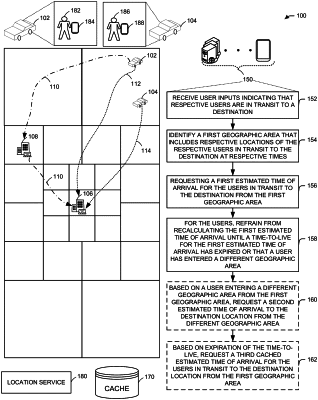| CPC G06Q 10/0833 (2013.01) [G06Q 50/30 (2013.01); H04W 4/022 (2013.01); H04W 4/029 (2018.02)] | 20 Claims |

|
1. A method for reducing cache calls and refreshes, the method comprising:
receiving, by at least one processor of a device, a first user input indicative of a first user being in transit to a destination location;
identifying, by the at least one processor, based on the first user input, a first location of a first device of the first user at a first time;
receiving, by the at least one processor, a second user input indicative of a second user being in transit to the destination location;
identifying, by the at least one processor, based on the second user input, a second location of a second device of the second user at a second time;
determining, by the at least one processor, for the first user, based on the first time, a first estimated time of arrival from a first geographical area to the destination location, the first geographical area comprising the first location and the second location;
determining, by the at least one processor, for the second user, based on the second time, the first estimated time of arrival;
presenting, by the at least one processor, for the first user, based on the first time, the first estimated time of arrival;
presenting, by the at least one processor, for the second user, based on the second time, the first estimated time of arrival;
identifying, by the at least one processor, a third location of the first device at a third time, wherein the third location is within the first geographical area;
determining, by the at least one processor, that a time-to-live (TTL) of the first estimated time of arrival has not expired at the third time;
refraining, by the at least one processor, from recalculating the first estimated time of arrival based on the determination that the TTL has not expired at the third time; and
presenting, by the at least one processor, for the first user, based on the third time, the first estimated time of arrival.
|